
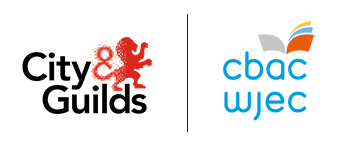


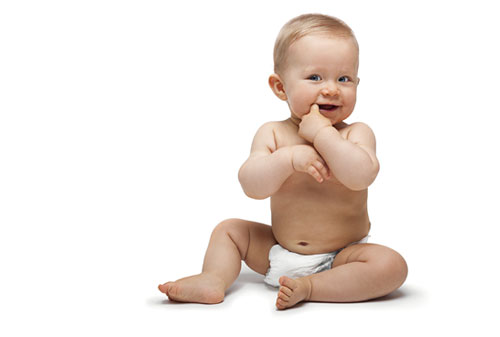
Physical development is divided into two, namely growth and development.
Growth represents the physical changes, the increase in size, height and weight.
Development involves the way in which children take control of their physical functions in order to undertake complex and difficult activities more easily and intricately.
Growth and development are connected as the development of physical skills relies on the child's size and muscular strength. Physical development will usually be in sequence although a child's age may vary. Several factors may affect the sequence, such as a disability.
This involves the development and control of the entire body and larger muscles. Children need this control in order to balance, walk and climb. New-borns do not have much control over their bodies, but as they grow older their control grows. Children learn how to walk at a different rate to one another, with some learning to walk at 9 months old, whilst others are 12 months old and some are 18 months old.
Development moves from the head and down the body through the arms, hands, back, legs and feet. The downwards pattern is also relevant to ossification, namely the way in which children's bones harden. The bones of the hand harden before the bones of the feet. Ossification continues until the child reaches their teens.
Controlling the head
Rolling over
Sitting
Crawling
Standing
Walking
Running
Hopping
Climbing
This involves the development and control of the smallest muscles of the hands, fingers and feet so that the child can undertake finer tasks, e.g. drawing a picture, buttoning and threading beads. Development moves from the inside out, with functions close to the body developing into functions further away from the body, such as using the arm to reach out for an object before being able to use the fingers to pick the object up.
3 months - playing with the fingers
6 months - palmar grip (using the whole hand)
9 months - inferior pincer grip (using the index finger and thumb)
12 months - primitive tripod grip (thumb and two fingers)
15 months - palmar grip (to hold a crayon)
18 months - fine pincer grip and tripod grip
2 years old - one hand dominates
2 ½ years old - improved tripod grip
4 years old - mature pincer grip
Further reading
Mae datblygiad corfforol wedi ei rannu'n ddau sef, twf a datblygiad.
Twf yw'r newidiadau ffisegol, y cynnydd mewn maint, taldra a phwysau.
Datblygiad yw sut mae plant yn ennill rheolaeth dros eu gweithredoedd corfforol er mwyn cyflawni gweithgareddau cymhleth ac anodd yn haws ac yn fwy medrus.
Mae twf a datblygiad yn gysylltiedig oherwydd bod datblygiad sgiliau corfforol yn dibynnu ar faint y plentyn a'u cryfder cyhyrol. Fel arfer bydd datblygiad corfforol yn ddilyniant er y gall oedran plant amrywio ar y dilyniant hwnnw. Gall sawl ffactor effeithio ar y dilyniant, er enghraifft anabledd.
Dyma ddatblygiad a rheolaeth y corff cyfan a'r cyhyrau mwy. Mae angen y rheolaeth yma ar blant er mwyn iddynt allu cydbwyso, cerdded a dringo. Nid oes gan fabanod newydd-anedig lawer o reolaeth dros eu cyrff ond wrth iddynt fynd yn hŷn, mae’r rheolaeth yn cynyddu. Mae plant yn dysgu'r rheolaeth i gerdded ar gyfradd wahanol i’w gilydd gyda rhai yn dysgu cerdded yn 9 mis oed, eraill yn 12 mis ac eraill yn 18 mis oed.
Mae datblygiad yn symud o'r pen ac i lawr y corff drwy'r breichiau, dwylo, cefn, coesau a thraed. Mae'r patrwm ar i lawr hefyd yn berthnasol i asgwrneiddiad, sef y ffordd y mae esgyrn plant yn caledu. Mae esgyrn y dwylo'n caledu cyn esgyrn y traed. Nid yw asgwrneiddiad yn dod i ben nes bod y plentyn yn ei arddegau.
Rheoli’r pen
Rholio drosodd
Eistedd
Cropian
Sefyll
Cerdded
Rhedeg
Hercian
Dringo
Dyma ddatblygiad a rheolaeth cyhyrau lleiaf y dwylo, y bysedd a'r traed fel y gall plentyn wneud tasgau mwy manwl, e.e. tynnu lluniau, cau botymau ac edafu gleiniau. Mae datblygiad yn symud o'r tu mewn i'r tu allan gyda gweithrediadau sy’n agos at y corff yn datblygu i weithrediadau ymhellach oddi wrth y corff, megis defnyddio'r fraich i ymestyn am wrthrych cyn gallu defnyddio'r bysedd i godi'r gwrthrych.
3 mis - chwarae â’r bysedd
6 mis - gafael cledrol (defnyddio’r llaw gyfan)
9 mis - gafael pinsiwrn isradd (defnyddio’r mynegfys a’r bawd)
12 mis - gafael trybedd gysefin (bawd a dau fys)
15 mis - gafael cledrol (i ddal creon)
18 mis - gafael pinsiwrn manwl a gafael trybedd
2 oed - blaenoriaeth i un llaw
2 ½ oed - gafael trybedd wedi gwella
4 oed - gafael pinsiwrn aeddfed
Darllen pellach
Physical development norms
Click on an age milestone and select the appropriate statement from the list.
Normau datblygiad corfforol
Cliciwch ar garreg filltir oedran a dewiswch y gosodiad priodol o’r rhestr.
Well done. You scored … out of ….
Da iawn. Mae gennych … allan o … yn gywir.
You scored … out of …. Some of the answers you gave are incorrect. Try again to improve your score.
Mae gennych … allan o … yn gywir. Mae rhai o'ch atebion yn anghywir. Ceisiwch eto i wella eich sgôr.
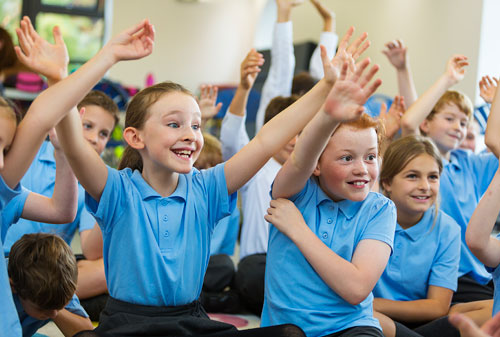
Social development involves the learning of skills and attitudes which allow individuals to live with other members of the community easily. It also increases the child's capacity to live independently in society.
Social development follows a similar pattern everywhere, although some countries have different social practices. From birth, a baby will be aware of people and will spend a great deal of time watching and copying.
During their social development a child will learn how to:
Examples of social skills:
Babies and children develop at a different rate but there are some common milestones in their social development.
By 12 months babies will be able to differentiate between members of the family/carers and socialise with them. They will make specific sounds to draw attention and will offer a book or toy to adults.
Tantrums are common as children seek independence. They will participate in role play, copying what the adults around them are doing. They will also be interested in other children, but they will tend to play alongside them rather than with them.
Children will be happier separated from their parents/carers playing with other children of the same age. They will be kind and caring with other children.
Children of this age are happy and curious, but they can also be selfish and argumentative. They can start to withdraw from the family/carers as they develop their own identity. They are aware of their gender and prefer playing with children of the same gender.
Children become more independent and can become moody and need more privacy. Peer groups are important to children of this age and they can start to experiment with fashion in order to carve out their identity.
Datblygiad cymdeithasol yw’r broses o ddysgu’r sgiliau ac agweddau sy’n galluogi unigolion i fyw yn hawdd gydag aelodau eraill yn eu cymuned. Mae hefyd yn golygu cynnydd yng ngallu’r plentyn i fod yn annibynnol o fewn ei gymdeithas.
Mae datblygiad cymdeithasol yn dilyn patrwm tebyg ym mhob man, er bod rhai gwledydd yn dilyn arferion cymdeithasol gwahanol. O'r adeg y caiff babi ei eni, mae’n ymwybodol o bobl ac yn treulio llawer o amser yn eu gwylio ac yn eu copïo.
Wrth ddatblygu’n gymdeithasol bydd plentyn yn dysgu sut i:
Enghreifftiau o sgiliau cymdeithasol:
Mae babanod a phlant yn datblygu ar raddfa wahanol ond mae rhai cerrig milltir cyffredin yn eu datblygiad cymdeithasol.
Erbyn deuddeg mis bydd babanod yn gwahaniaethu rhwng aelodau o’r teulu ac yn cymdeithasu â nhw. Byddant yn gwneud synau penodol er mwyn denu sylw ac yn cynnig llyfr neu degan i oedolion.
Mae strancio yn gyffredin wrth i blant bach geisio dod yn annibynnol. Byddant yn chwarae rôl, gan gopïo beth mae'r oedolion o'u cwmpas yn ei wneud. Bydd ganddynt ddiddordeb mewn plant eraill hefyd, ond byddant yn tueddu i chwarae ochr yn ochr â hwy yn hytrach na gyda nhw.
Bydd plant yn hapusach i wahanu oddi wrth riant gan chwarae gyda phlant eraill yn yr oed yma. Byddant yn garedig a gofalgar tuag at blant eraill.
Mae plant yr oed yma yn hapus ac yn chwilfrydig, ond gallant hefyd fod yn hunanol a dadleuol. Gallant ddechrau tynnu'n ôl ychydig o'r teulu wrth iddynt ddatblygu eu hunaniaeth eu hunain. Maent yn ymwybodol o'u rhyw ac mae'n well ganddynt chwarae gyda phlant o'r un rhyw.
Mae'r plant yn dod yn fwy annibynnol a gallant ddod yn bwdlyd ac angen mwy o breifatrwydd. Mae grwpiau cyfoedion yn bwysig i blant yn yr oed yma a gallant ddechrau arbrofi gyda ffasiwn er mwyn canfod eu hunaniaeth.
Social development norms
Click on an age milestone and select the appropriate statement from the list.
Normau datblygiad cymdeithasol
Cliciwch ar garreg filltir oedran a dewiswch y gosodiad priodol o’r rhestr.
Well done. You scored … out of ….
Da iawn. Mae gennych … allan o … yn gywir.
You scored … out of …. Some of the answers you gave are incorrect. Try again to improve your score.
Mae gennych … allan o … yn gywir. Mae rhai o'ch atebion yn anghywir. Ceisiwch eto i wella eich sgôr.
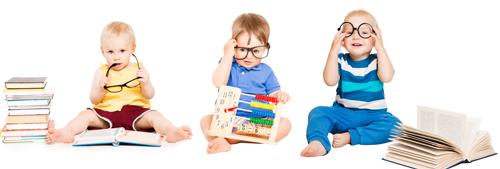
Intellectual development, also known as cognitive development, involves the development of the mind and includes language development. Children learn how to reason, think, understand and explain things. Most children will experience the same pattern of intellectual development and children will usually reach milestones at the same time more or less.
Children will learn about the world around them through observation, emulation, experience and failure, play, exploration, using the senses and experimentation. Once a child is able to move around, their intellectual development will accelerate as they are provided with new experiences to learn from.
Intellectual development includes memory, concentration, reasoning, perception, imagination and creativity and problem solving. It is important for adults to provide a stimulating environment for children as well as new experiences which will help to promote their development, such as games, books, toys, outdoor experiences and various types of play.
Children develop language skills very quickly between 0 and 5 years old. When a child is born, they are able to communicate their needs by crying and using facial expressions which lasts for the first 12 months. The ability to understand language normally occurs before the ability to communicate. Children will start to communicate verbally by babbling and then by using one or two words. This then turns into putting two words together, then three, and then whole sentences. Once a child is two, they will be able to say more than 200 words, and will learn new words very quickly. The increase in vocabulary is influenced by how much language is heard by the child. By six the child will have more than 10,000 words in their vocabulary. An eight-year old will be able to have conversations with adults.
Mental capacity involves our use of the mind to understand the world around us. It depends on the child's individual pattern of development, the opportunity to play with toys and games and experiences of activities and events.
Intellectual development includes:
Mae datblygiad deallusol, a elwir hefyd yn ddatblygiad gwybyddol, yn ymwneud â datblygiad y meddwl ac mae’n cynnwys datblygiad iaith. Mae plant yn dysgu sut i resymu, meddwl, deall ac esbonio pethau. Yn achos y rhan fwyaf o blant mae’r patrwm datblygiad deallusol fel rheol yn dilyn yr un drefn ac fel rheol, mae plant yn cyrraedd cerrig milltir ar yr un pryd fwy neu lai.
Bydd plant yn dysgu am y byd o’u cwmpas trwy arsylwi, dynwared, profi a methu, chwarae, archwilio, defnyddio’u synhwyrau ac arbrofi. Unwaith y gall plentyn symud o gwmpas, bydd eu datblygiad deallusol yn cyflymu wrth iddynt gael mwy o brofiadau newydd i ddysgu oddi wrthynt.
Mae datblygiad deallusol yn cynnwys cof, canolbwyntio, rhesymu, canfyddiad, dychymyg a chreadigrwydd a datrys problemau. Mae’n bwysig bod oedolion yn darparu amgylchedd ysgogol i blant ynghyd â phrofiadau newydd a fydd yn helpu i hybu eu datblygiad, fel gemau, llyfrau, teganau, profiadau yn yr awyr agored ac amrywiol fathau o chwarae.
Mae plant yn datblygu sgiliau iaith yn gyflym iawn rhwng 0 a 5 oed. Pan gaiff plentyn ei eni, gall gyfathrebu ei anghenion trwy grio a defnyddio mynegiant y wyneb, ac fe fydd hyn yn parhau am y 12 mis cyntaf. Mae'r gallu i ddeall iaith fel arfer yn digwydd cyn y gallu i gyfathrebu. Mae'r plant yn dechrau cyfathrebu ar lafar trwy faldorddi (babble) ac yna trwy ddefnyddio un neu ddau o eiriau. Mae hyn wedyn yn troi i mewn i roi dau air gyda'i gilydd, ac yna tri, ac yna brawddegau cyfan. Unwaith y bydd plentyn yn ddwy oed, maent yn siarad mwy na 200 o eiriau, ac yn dysgu geiriau newydd yn gyflym iawn. Mae’r cynnydd yn yr eirfa yn cael ei ddylanwadu gan faint o iaith mae’r plentyn yn clywed. Erbyn i’r plentyn gyrraedd chwech oed mae ganddo eirfa o dros 10,000 o eiriau. Bydd plentyn wyth oed yn gallu cynnal sgyrsiau fel oedolion.
Mae gallu meddyliol yn ymwneud â sut rydym yn defnyddio ein meddyliau er mwyn deall y byd o'n hamgylch. Mae'n dibynnu ar batrwm datblygiad unigol y plentyn, y cyfle i chwarae gyda theganau a gemau a phrofiadau o weithgareddau a digwyddiadau.
Mae datblygiad deallusol yn cynnwys:
Intellectual development norms
Click on an age milestone and select the appropriate statement from the list.
Normau datblygiad deallusol
Cliciwch ar garreg filltir oedran a dewiswch y gosodiad priodol o’r rhestr.
Well done. You scored … out of ….
Da iawn. Mae gennych … allan o … yn gywir.
You scored … out of …. Some of the answers you gave are incorrect. Try again to improve your score.
Mae gennych … allan o … yn gywir. Mae rhai o'ch atebion yn anghywir. Ceisiwch eto i wella eich sgôr.
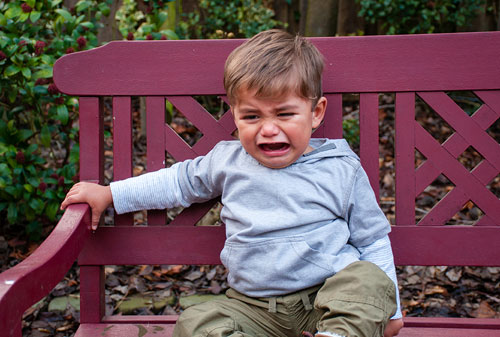
Emotional development involves an individual's feelings about other people, objects, situations and experiences. Adults can use words to express their feelings and explain how they are feeling. Children cannot do this as easily as they may not have the words to describe how they are feeling. Therefore, they express their feelings by:
Children need to be supported to control their feelings. Feelings of anger, frustration, disappointment, sadness and shame can feel overwhelming to a young child. Learning that these emotions are normal and how to deal with them positively helps the child grow into an emotionally stable person and understand other people's feelings. As a child develops emotionally they will be able to express a range of emotions and control feelings and behaviour in an appropriate manner.
A baby will develop an emotional bond with their main carer during the first 18 months of their life, which is important as this provides them with stability and security. The strong attachment which develops between parents/carers and their baby makes parents/carers want to love and care for them. The attachment between the baby and mother starts immediately from birth as the baby responds to the love and attention they receive. A strong attachment gives the baby an appropriate foundation for life. An uncertain attachment does not meet the needs of babies, and this can lead to confusion in terms of their identity and difficulties in learning and interacting with others as they grow older.
Self-esteem is the way in which a person feels about themselves. People with high self-esteem like themselves, but recognise that there are things they could work on and improve. They will be less likely to experience social and emotional issues, and will have the resilience to work through problems. People with low self-esteem may feel that they are not good enough and that nobody likes them. People with low self-esteem also invariably have low self-confidence, and as a result find it difficult to recognise their strengths.
People with self-confidence can trust in themselves and their abilities. Self-confidence and self-esteem do not necessarily go hand in hand. For example, a singer may feel confident when performing in front of thousands, but due to low self-esteem they may harm themselves with drugs and alcohol.
Mae datblygiad emosiynol yn ymwneud â theimladau unigolyn am bobl, gwrthrychau, sefyllfaoedd a phrofiadau eraill. Mae oedolion yn gallu defnyddio geiriau i fynegi eu teimladau ac esbonio sut maen nhw'n teimlo. Ni all plant wneud hyn mor hawdd oherwydd efallai nad oes ganddynt y geiriau i ddisgrifio sut maen nhw'n teimlo. Felly, maent yn mynegi eu teimladau trwy:
Mae angen cefnogi plant wrth reoli eu teimladau. Gall teimladau o ddicter, rhwystredigaeth, siom, tristwch, a chywilydd deimlo'n llethol i blentyn bach. Mae dysgu bod yr emosiynau hyn yn normal a sut i ymdopi â nhw mewn modd cadarnhaol, yn helpu plentyn i dyfu i fod yn berson sefydlog yn emosiynol ac i ddeall teimladau eraill. Wrth i blant ddatblygu’n emosiynol gallent fynegi ystod o emosiynau a rheoli teimladau ac ymddygiad mewn ffordd briodol.
Mae babi yn datblygu bond emosiynol gyda'i brif ofalwyr dros 18 mis cyntaf eu bywyd, sy’n bwysig gan ei fod yn rhoi sefydlogrwydd a diogelwch i’r babi. Mae’r ymlyniad cryf sy'n datblygu rhwng rhieni a'u babi yn gwneud i rieni eisiau rhoi llawer o gariad ac anwyldeb iddynt a gofalu amdanynt. Mae ymlyniad rhwng y babi â’i fam yn dechrau yn syth ar ôl geni wrth i’r babi ymateb i’r cariad a’r sylw y mae’n ei dderbyn. Mae ymlyniad cadarn yn rhoi sylfaen priodol i’r babi ar gyfer bywyd. Nid yw ymlyniad ansicr yn bodloni anghenion babanod, a gall arwain at ddryswch ynghylch eu hunaniaeth ac anawsterau wrth ddysgu ac ymwneud ag eraill wrth iddynt fynd yn hŷn.
Hunan-barch yw sut mae person yn teimlo amdanynt eu hunain. Mae pobl â hunan-barch uchel yn hoffi eu hunain, ond yn cydnabod bod yna bethau y gallent weithio arnynt a’u gwella. Byddant yn llai tebygol o fod â phroblemau cymdeithasol ac emosiynol, a gyda’r gwytnwch i weithio drwy broblemau. Gall pobl â hunan-barch isel deimlo nad ydynt yn ddigon da a bod neb yn eu hoffi. Mae pobl â hunan-barch isel hefyd yn aml yn meddu ar hunanhyder isel, ac o’r herwydd yn ei chael yn anodd cydnabod eu cryfderau.
Mae pobl sydd â hunanhyder yn gallu ymddiried ynddynt eu hunain a’u galluoedd. Nid yw hunanhyder a hunan-barch o reidrwydd yn mynd law yn llaw. Er enghraifft, gall canwr deimlo'n hyderus wrth berfformio o flaen miloedd o bobl, ond oherwydd hunan-barch isel gall niweidio ei hun â chyffuriau ac alcohol.
Stages of emotional development
Click on an age milestone and select the appropriate statement from the list.
Camau datblygiad emosiynol
Cliciwch ar garreg filltir oedran a dewiswch y gosodiad priodol o’r rhestr.
Well done. You scored … out of ….
Da iawn. Mae gennych … allan o … yn gywir.
You scored … out of …. Some of the answers you gave are incorrect. Try again to improve your score.
Mae gennych … allan o … yn gywir. Mae rhai o'ch atebion yn anghywir. Ceisiwch eto i wella eich sgôr.